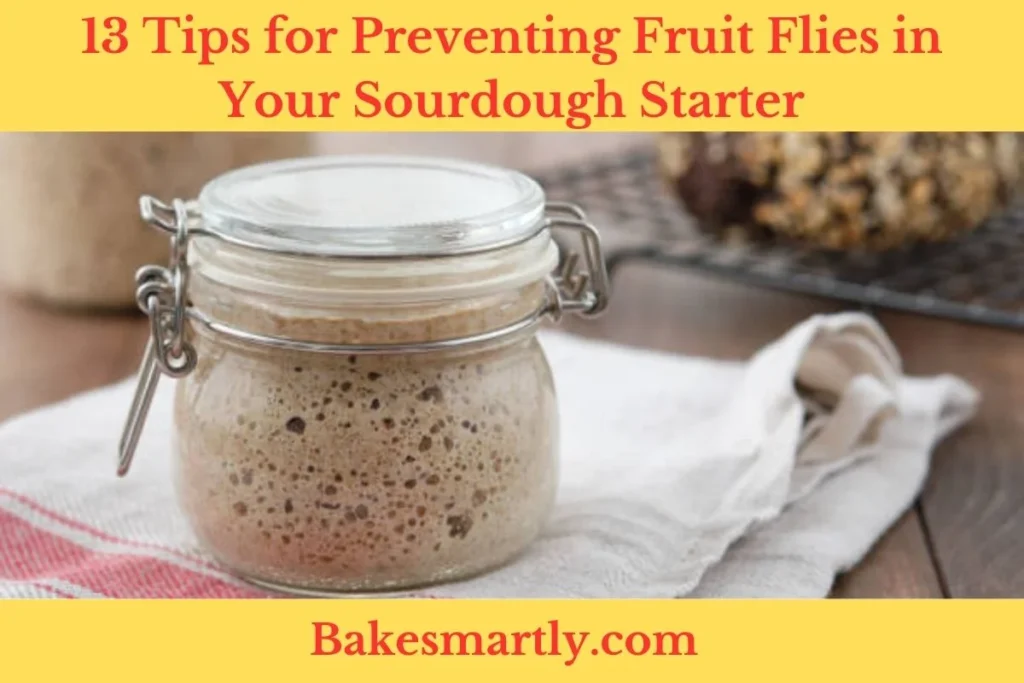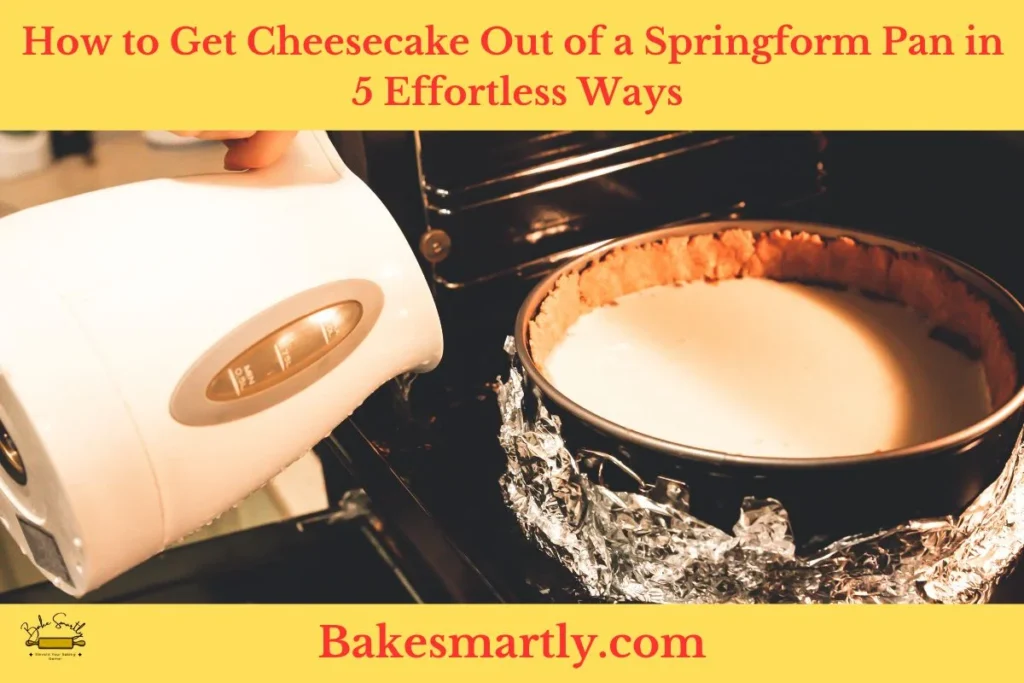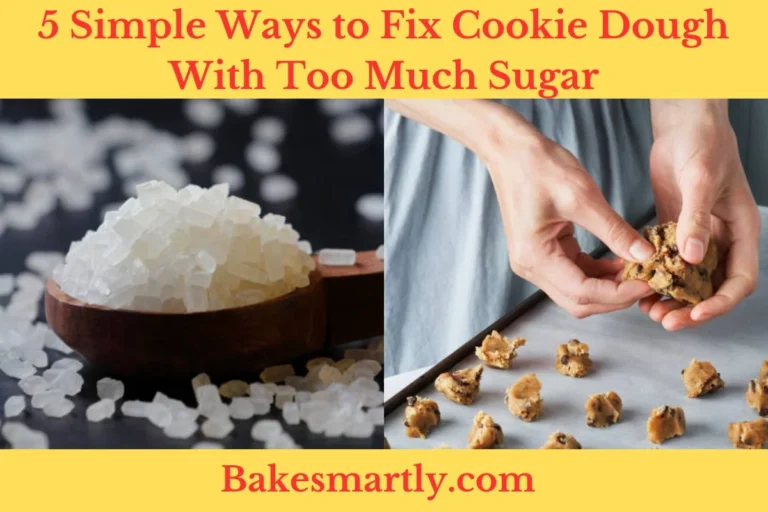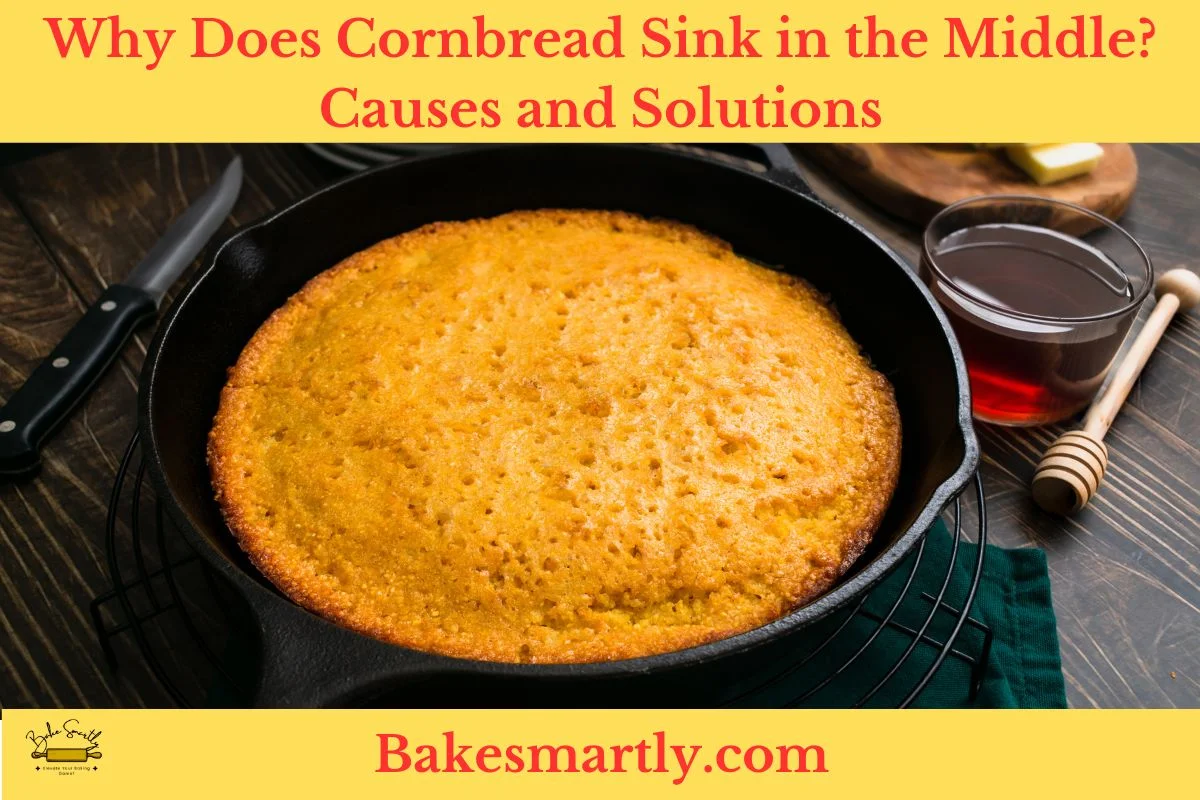
Why Does Cornbread Sink in the Middle? Causes and Solutions
Hey there, Bread bakers! Can you relate to the excitement of pulling a golden-brown cornbread out of the oven, only to be greeted by a disappointingly sunken middle?
Don’t worry, it happens to the best of us. In my baking adventures, I’ve faced that dreaded sunken cornbread more times than I’d care to admit. That’s why I dug into the reasons and fixes to save your cornbread game.
Come along in this blog we discuss into the four common causes of sunken cornbread – we’ll tackle rising power, mixing techniques, oven temperatures, and ingredient ratios. Let’s turn those sunken middles into culinary victories with some practical solutions!
If you’ve ever wondered why your cornbread isn’t rising like it should, stick around for expert tips, a step-by-step guide on rescuing sunken cornbread, to make sure your next batch is a soaring success.
Table of Contents
Toggle4 Common Reasons Why Your Cornbread is Sinking in the Middle
Cornbread sinking in the middle can be a bit disappointing, but don’t worry! Let’s break down the usual reasons behind this baking issue and check out some practical solutions to make sure your cornbread turns out just right.
1. Not Enough Rising Power
One big reason your cornbread might sink is not having enough rising power. Whether you’re using baking powder, baking soda, or a mix of both, if you don’t use the right amount, your cornbread won’t puff up like it should. If you’re short on rising power, your cornbread might end up heavy and sunken in the middle.
Fix: Check your recipe to make sure you’ve got the right amount of rising stuff. Also, check those expiration dates; old baking powder or soda won’t give your cornbread the lift it needs. Try sifting your dry ingredients to spread the rising power evenly, so your cornbread rises up nice and even.
2. Too Much Mixing
It might be tempting to mix your batter until it’s super smooth, but too much mixing can make your cornbread tough and sunken. Too much stirring makes too much gluten, and that gets in the way of your cornbread rising like it should.
Fix: Mix your cornbread batter until everything just comes together. It’s totally okay to have a few lumps – way better than overmixing. Be gentle when you mix wet and dry stuff together, using a light touch. This way, you won’t end up with too much gluten, and your cornbread will rise up the way it’s supposed to.
3. Wrong Oven Temperature
Baking is a tricky combination of time and heat. If your oven is too hot or too cold, it messes with how your cornbread turns out. Too hot, and the edges set too fast, leaving the middle all sunken. Too cold, and your cornbread bakes unevenly.
Fix: Grab an oven thermometer to make sure your oven is doing what it says it’s doing. Heat up your oven completely before you pop in your cornbread to make sure it’s the right temp. Keep an eye on the clock, but start checking a bit early to avoid overdoing it.
4. Liquid and Dry Mix-Up
Getting the right mix of liquid and dry stuff is key for perfect cornbread. Too much liquid makes a heavy batter, while too little makes your cornbread dry and crumbly. Both can lead to a sunken middle.
Fix: Measure your ingredients carefully, especially the liquid ones. Use the right cups for the job – liquid ones for liquids and dry ones for dry stuff – to make sure you’re spot on. Adjust the mix if you need to, adding a bit more liquid or dry stuff to get your cornbread batter just right.
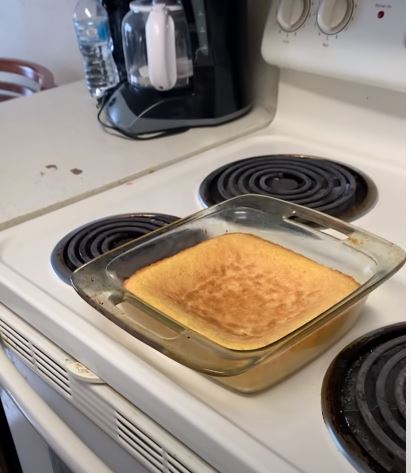
How to Fix Sunken Cornbread in the Middle | Step-by-Step
Few things bum out a home baker more than pulling a perfectly crafted cornbread from the oven, only to find a saggy middle. But don’t freak out—this hiccup is totally fixable. With a little know-how and a step-by-step plan, you can rescue your sunken cornbread and make it a culinary win.
- Step 1: Check the Damage: Before you start fixing things, take a sec to see how bad the sunken middle is. Is it a small dip or a major collapse? Knowing how bad it is will help you figure out what to do next.
- Step 2: Let It Cool: Give your cornbread some time to cool down completely before trying any fixes. Even though you might want to jump in right away, letting it cool makes sure the structure settles and stops any further damage when you start messing with it.
- Step 3: Trim and Even Out: If the sunken middle is big, think about trimming the excess from the edges to make a flat surface. Use a serrated knife or a cake leveler to carefully take off the sunken part without wrecking the whole cornbread.
- Step 4: Make a Space: If the sunken middle is small, make a little pocket in the center with a knife. This gives you a spot to add extra filling or topping, turning the sunken part into a cool feature instead of a problem.
- Step 5: Whip Up a Tasty Filling: To boost the flavor and hide the sunken part, make a filling that goes with your cornbread. You could use whipped cream, fruit compote, or a savory spread, depending on whether your cornbread is sweet or savory. Make sure the filling is at room temperature to avoid messing up the temperatures.
- Step 6: Fill the Gap: If you made a pocket, gently fill it with your chosen filling. If you trimmed the edges, think about spreading the filling over the whole top. This not only adds flavor but also hides any imperfections.
- Step 7: Add Some Flair: To draw attention away from the sunken middle, give your cornbread a little something extra. Sprinkle on powdered sugar, drizzle some glaze, or add herbs, depending on the taste of your cornbread.
- Step 8: Get to the Bottom of It: Even though you fixed the problem for now, it’s important to figure out what caused it in the first place. Look at your recipe and baking process, paying attention to things like leavening agents, mixing techniques, oven temperature, and ingredient ratios.
- Step 9: Change Up Your Baking Game: Next time you bake, make adjustments based on what you learned. Use the right amount of leavening agents, mix the batter just enough, double-check the oven temperature, and keep the liquid-to-dry ratio on point. These changes will help you nail it in the future.
Why Does My Cornbread Puff up in the Middle?
Cornbread often puffs up in the middle for a few reasons, mostly tied to the science of baking. Knowing these factors can help home bakers make consistently well-risen cornbread.
A big player in the center’s rise is the leavening agent in the recipe, usually baking powder or baking soda. These agents release carbon dioxide gas when they heat up, creating bubbles that make the batter expand. If the leavening agents aren’t evenly spread or if the batter is too thick, the gas might gather more in the middle, making it rise unevenly.
Another thing to think about is oven temperature and preheating. If the oven isn’t heated enough, the cornbread might cook unevenly, with the edges cooking faster than the center. As the heat continues, the center catches up, causing a noticeable rise in the middle.
The choice of ingredients is also important. Mixing the batter too much can add too much air, leading to uneven rising. Also, the type of flour, how fresh the leavening agents are, and the ratio of wet to dry ingredients all affect the batter’s consistency and, consequently, the shape of the cornbread.
To tackle this issue, it’s crucial to follow the recipe closely, paying attention to the order of adding ingredients, using the right mixing techniques, and making sure the oven is well-heated. Adjusting ingredient amounts, trying different leavening agents, or experimenting with alternative flours can also help fine-tune the texture and rise of your cornbread.
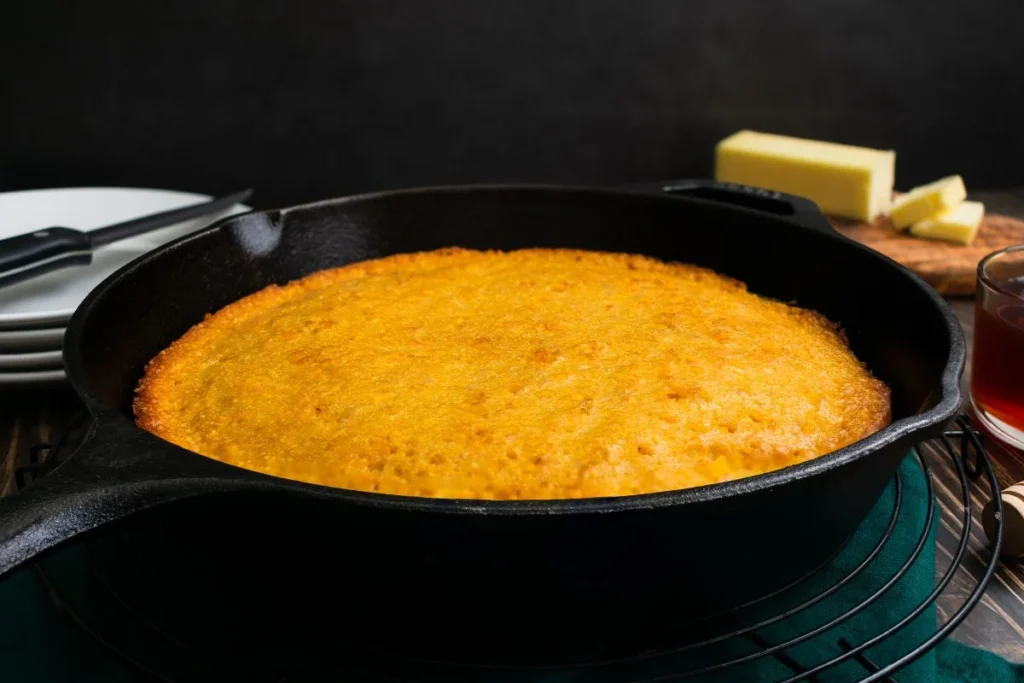
8 Expert Tips for Avoiding Sinking Cornbread
To make sure your cornbread comes out of the oven as a culinary success, follow these simple tips to avoid the dreaded sinking phenomenon:
- Accurate Measurements: Getting the right measurement of ingredients is key to cornbread success. Use proper measuring cups for both dry and liquid ingredients, and level off your measurements to maintain the right balance.
- Fresh Leavening Agents: Check the expiration dates on your baking powder and baking soda. Fresh leavening agents are crucial for the proper rise of your cornbread. Replace them regularly to ensure optimal performance.
- Gentle Mixing: Avoid overmixing, which can lead to excess gluten formation, resulting in a dense and sunken texture. Mix your batter just until the ingredients are combined, leaving some small lumps if necessary.
- Preheat Your Oven: Make sure your oven is thoroughly preheated before putting the cornbread inside. A consistent and accurate temperature is essential for even baking and proper rising.
- Check Oven Temperature: Verify your oven’s temperature with an oven thermometer. Too high a temperature can cause the edges to set too quickly, while too low a temperature may result in uneven baking.
- Get the Liquid-to-Dry Ratio Right: Finding the right balance between liquid and dry ingredients is crucial. Measure carefully, using the appropriate measuring tools, to achieve the ideal consistency for your cornbread batter.
- Don’t Overdo Mix-ins: While nuts, fruits, or cheese can add delightful flavors, too many can weigh down the batter, leading to a sunken middle. Use mix-ins judiciously and adjust your recipe accordingly.
- Choose the Right Pan: The type of pan you use can impact the baking process. Opt for a light-colored metal or glass pan, as dark pans can absorb more heat and potentially cause uneven baking.
Frequently Asked Question (FAQS)
What happens if you overmix cornbread?
Overmixing cornbread leads to excessive gluten formation, resulting in a dense and tough texture. The batter should be mixed just until ingredients combine—overdoing it hinders proper rising during baking. To avoid a disappointing outcome, keep the mixing gentle, allowing your cornbread to achieve the perfect balance of tenderness and flavor.
why does my cornbread rise in the middle
Cornbread rising unevenly in the middle may result from incorrect oven temperature or too much leavening agent. Ensure accurate preheating, use an oven thermometer, and measure leavening agents precisely. Overmixing or uneven mixing can also disrupt the batter’s consistency, impacting the rise. Follow recommended techniques and ingredient ratios for perfectly even cornbread.
How do I prevent cornbread from sinking?
Ensuring accurate ingredient measurements, avoiding overmixing, and managing oven temperature are key to preventing cornbread from sinking.
Why Does Cornbread Sink in the Middle | Final Thoughts
In the wonderful world of baking, we’ve all experienced the disappointment of cornbread sinking. Don’t worry, Bread bakers, because this blog has uncovered the reasons behind the Sunken Middle and provided you with solutions. From mastering how to make it rise properly to refining mixing techniques, understanding oven temperatures, and balancing ingredient ratios, we’ve explored the journey to perfect cornbread.
For those dealing with sunken middles, our step-by-step rescue plan is here to help. Trim, fill, and decorate – transform that baking hiccup into a success. As we say goodbye, keep these expert tips in mind for future baking victories. Happy baking!
Lindsey Mackenzie
About me
Hi there! I’m Lindsey Mackenzie, the founder of Bake Smartly. Baking has been my passion since childhood, growing up in my father’s bakery. With Bake Smartly, I’m excited to share my love for all things sweet and savory. Join me on this delicious journey as we whip up scrumptious treats and sprinkle joy into every bite!

